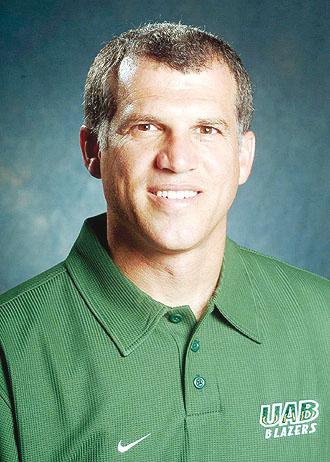Getman Championed Championships at Region Park

HOOVER, Ala. — Mike Getman gets it.
As the de facto ambassador for Division I men’s soccer in this part of the country, the University of Alabama at Birmingham coach couldn’t help but smile. His work was done.
He and a crowd of 9,242 had just watched Indiana University defeat Georgetown University 1-0 to win the Men’s College Cup at Regions Park.
The combined crowds of 20,316 watched three matches Friday and Sunday that featured the highs and lows that make soccer wonderful. Getman was especially happy because the attendance was nearly 2,000 more than the mark of 18,400 from 2011 in Hoover’s initial year as host of the sport’s premier event.
But Getman knows the hard work he, members of the Alabama Sports Foundation, and everyone else invested in the past two years is just a start.
In a region where American football remains king — 365 days a year, according to one of the region’s top sports radio stations — Getman knows men’s and women’s soccer coaches have to get out and sell their sport and their schools to help the sport grow. In a small way, he feels he helped accomplish that goal by lobbying to bring the showcase to Alabama and making it a success.
“Yes, it is football country, but people here love this sport as well,” Getman said.
Getman cited the success Birmingham, Ala., had when Legion Field had a crowd of 83,810 for the opening match of the 1996 Olympic Games between the United States and Argentina. Legion Field also has played host to exhibition games for the U.S. men’s and women’s National Teams.
In 2005, a crowd of 31,624 watched the U.S. men beat Guatemala 2-0 in a World Cup qualifier.
But the question remained whether fans would support a NCAA event in a state where UAB is its only Division I school that offers men’s soccer. Getman believed it would because Hoover, Ala., was in a great location, it had a great stadium, and good weather.
More than 30 minutes after the final, Getman was thanking everyone who came out and experienced the event.
“I don’t think you can have a more exciting weekend than what we had,” Getman said. “We had great games, exciting goals, the passion of a national championship. If you don’t get your blood pumping in something like this, we can’t help you.
As much progress as men’s soccer made this weekend, it has an even longer road to travel. The recent news that Mount St. Mary’s University, Towson University, and the University of Richmond will drop their men’s soccer programs for the 2013 season is another blow to a sport that has seen the percentage of Division I schools that offer the sport shrink.
According to the College Sports Council, 197 of 306 Division I schools offered men’s soccer in 1995-96. In 2008-09, 197 of 333 schools offered the sport (59.2 percent).
The University of Kentucky and the University of South Carolina are the only schools in the Southeastern Conference that offer men’s soccer as a Division I sport. All of the 14 SEC’ schools sponsor Division I women’s soccer teams.
Getman hopes that changes. He said the loss of Mount St. Mary’s, Towson, and Richmond likely will be offset by the addition of a few more programs in the next few years as schools opt to add the sport or move from Division II to Division I.
He doesn’t feel Title IX, the law that mandates equal opportunities for men and women, is a roadblock that is preventing more Division I schools from offering men’s soccer.
“Five years ago, there were 199 teams. This year, there were 2004, so is our sport growing or is it shrinking?,” Getman said. “There are soccer supporters and people who like to bash soccer. That’s been the case for 100 years.
“There are people who love the NFL and there are people who are saying it smashes up human beings and you shouldn’t be doing that. That’s OK. You can have whatever perspective you want, but the relevance of college soccer is really simple: These players, these fans, and the next generation love it and it is going to continue.”
In one semifinal, Georgetown and Maryland combined to score eight goals in a wide open 90 minutes of regulation. Neither scored in 20 minutes f overtime, so the game was settled by a penalty kick shootout. Two saves by goalkeeper Tomas Gomez on Maryland’s final two attempts helped Georgetown emerge with a 4-3 edge and advance to their first championship match.
In the other semifinl, Indiana, one of the sport’s traditional powers, preferred a more organized and defensive stance. It used a goal from Femi Hollinger-Janzen to edge Creighton University 1-0 in a game that showcased the sport’s clinical side.
Is the sport for everyone? Probably not. But in an age of youth sports specialization, soccer continues to grow in terms of the number of boys and girls playing the game.
Getman hopes more people — and schools — will give soccer a chance. If bringing the Men’s College Cup to Hoover succeeded in exposing the sport to only one more fan, Getman would call that a victory.
He wants more, though. That’s why he is going to continue to sell his sport and, he hopes, get the Men’s College Cup to come back to Alabama. Next year, the event will go to Philadelphia, and organizers will hope for a weekend that includes clear and partly cloudy skies and temperatures in the 60s.
Getman hopes UAB still will be alive that weekend. Either way, he will continue to work to expose even more people to the game he loves, and continue to offer opportunities for teenagers to become professional soccer players or to pursue other careers.
Judging from the work he and everyone did this weekend and in the past two years, there’s no doubt soccer will continue to grow.
